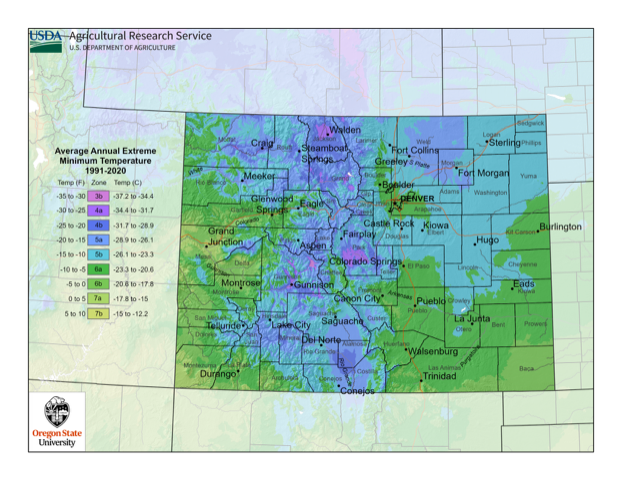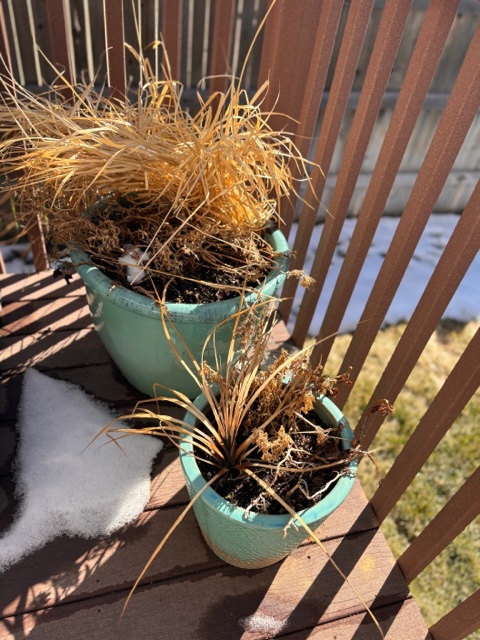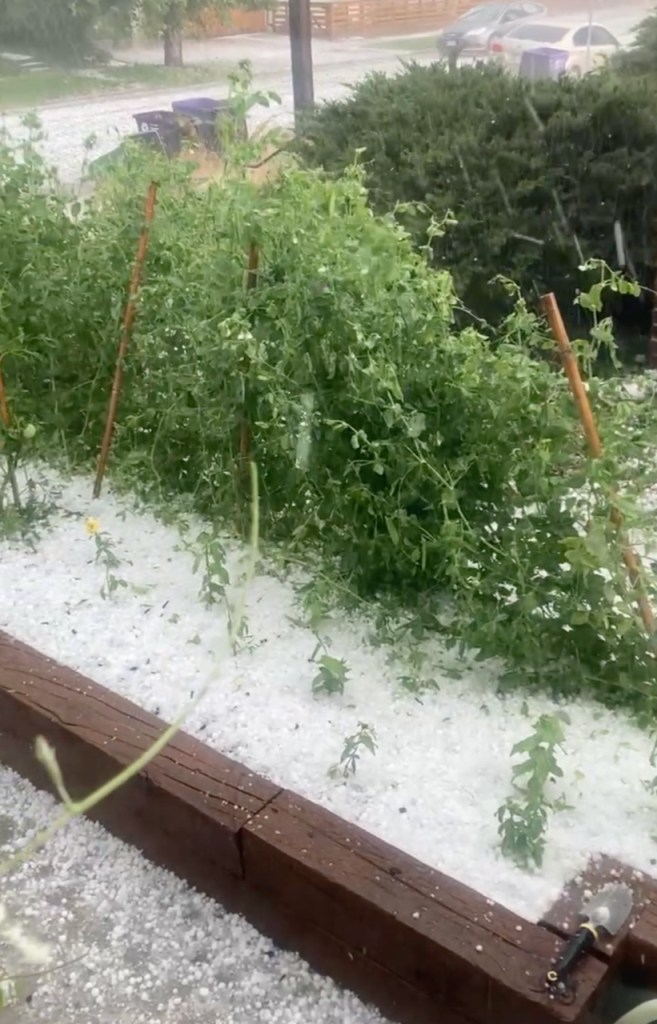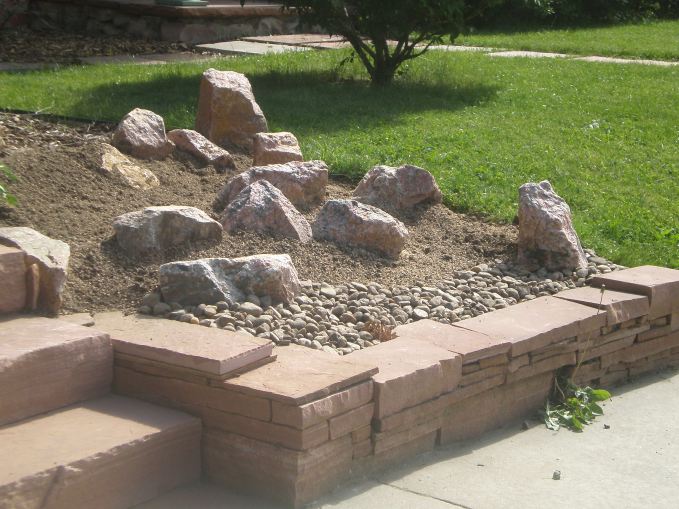By: Molly Gaines, CSU Extension-Denver Master Gardener since 2019

Signs of spring are everywhere in Denver. Daffodils, crocus and other spring flowers in full bloom one day; covered in ice and snow the next. Oh, to be a gardener at 5,280 feet!
While it’s too early to spend a lot of time planting, it’s a perfect time to prepare your soil, garden beds, tools, pots and lawn for the 2024 growing season. Below are a few gardening activities to consider before Mother’s Day, May 12 (around the safe zone from hard frosts) for planting most plants, flowers and vegetables.

As you plan your garden, it’s worth noting that some of the Denver metro is in a new gardening zone. Last November, the USDA announced updates to its “Plant Hardiness Zone Map,” updating this go-to tool for gardeners for the first time since 2012. The new map, which can be found here, places parts of Denver in Zone 6a rather than 5b. Zone numbers reflect the average extreme minimum temperatures and help determine what plants will thrive in each zone. Higher numbers equal incrementally warmer low temperatures. For background about how to use this map as a planting guide, visit this helpful article from the National Gardening Association’s learning library.

Vegetable Garden
- Clear remaining debris. Pull emerging weeds.
- When the soil is dry, add a fresh 2-3-inch layer of compost to your beds. This supports soil health and plant vigor. Gently work compost into the top layer of your existing soil with your hands, a trowel or a cultivator. Let rest a few weeks before planting.
- Plant frost-tolerant spring plantings, such as peas, spinach, arugula, radishes, Swiss chard, etc.
- Start indoor seeds for warm-weather vegetables such as tomatoes, peppers, squash, melons, etc.
- Reference this Vegetable Planting Guide to plan what you will plant when.
Trees & Shrubs
- The snowpack is solid Colorado-wide this year, well above 100 percent. This includes Denver. That said, if this month is dry, be sure to water your trees and shrubs.
- Early this month, prune deciduous trees, conifers and summer-blooming shrubs.
- Later in April into mid-May, prune rose bushes. For details on exactly how, why and when to do this, visit here. This is weather dependent so watch for low temperatures and delay if a cold snap is predicted.
- Remove broken branches from trees and clear dead leaves and decayed fruit from the base.
- If you’re looking to plant a new tree, consider the Park People’s annual fruit and yard tree sale that begins April 20. Trees range from $50 to $80, and sales support the Denver Digs program. More details can be found here.
Lawn Care
- Prep your mower, sharpening the blade as necessary and conducting other maintenance. Lawn mower blades should be sharpened at least once per season.
- If you use a pre-emergent weed product, apply in early April. For more details about how to use, visit here.
- Fertilize as desired, reading labels for proper application. Keep in mind that fall is the most important time for lawn fertilization. Applying only in the spring can mean excessive top growth and shallow root systems.
Perennial Beds
- Cut back perennial plants if this wasn’t done last fall, leaving 3 inches of the plant above the soil.
- Similar to your vegetable garden, the soil in these beds will also benefit greatly from compost, with the exception of native plants which generally prefer unamended soil.
- Pull emerging weeds now. Stay on top of them from the start.
- Divide overgrown perennials such as chives, sedum, grasses, phlox, daisies, hosta, etc. This will lead to healthier plants and better growth.
Other April Gardening Thoughts
- Assess garden supplies. Purchase or plan to borrow anything needed. Sterilize and sharpen garden tools.
- Empty any pots or containers still holding last year’s dead plantings. Clean and disinfect them to prevent disease in new plantings.

- Denver Water recommends waiting to turn on your irrigation until after the last freeze, typically in early May. Hand water until then.
- Sow wildflower and pollinator seed mixes.
- Prepare for frost, hail and other bad weather. Have sheets of plastic, old bedsheets and five-gallon buckets in easy reach for late-season snow or spring and summer hail. Remember the hailstorm that hit Denver late June last season?

Springtime in Denver is special. I love watching new life slowly unveil itself. It’s a time full of promise, new beginnings and high anticipation of the color, flavor and textures around the corner. The more prepared you are in April, the more enjoyable your summer gardening season will be.
As always, if you have questions about plants, planting and any other gardening and yard related topics, visit the CSU Extension Yard and Garden website for tips.


























 Passionate gardeners love to talk about gardening, so with that in mind, we recently asked Denver Master Gardeners for their best gardening advice. Responses included tried-and-true practices, creative suggestions and good reminders for all of us as the gardening season kicks into full gear.
Passionate gardeners love to talk about gardening, so with that in mind, we recently asked Denver Master Gardeners for their best gardening advice. Responses included tried-and-true practices, creative suggestions and good reminders for all of us as the gardening season kicks into full gear. Mulch, mulch, mulch is the mantra of many of our survey respondents as it keeps weeds out and moisture in. Add it like crazy each time you dig in the veggie, perennial and annual gardens and don’t forget container plants too. Small to medium-sized bark chips are popular, practical and pleasing to the eye. Natural mulch options are very effective, including not quite finished compost from the compost bin which will add carbon, feed living organisms, prevent water runoff and prevent compaction. Local arborists are often willing to drop off wood chips which would otherwise fill up the landfill. In the fall, mow over your leaves and spread them throughout the yard, they’ll breakdown by spring and add organic matter to your soil. Consider purchasing a chipper to grind up branches and other garden waste.
Mulch, mulch, mulch is the mantra of many of our survey respondents as it keeps weeds out and moisture in. Add it like crazy each time you dig in the veggie, perennial and annual gardens and don’t forget container plants too. Small to medium-sized bark chips are popular, practical and pleasing to the eye. Natural mulch options are very effective, including not quite finished compost from the compost bin which will add carbon, feed living organisms, prevent water runoff and prevent compaction. Local arborists are often willing to drop off wood chips which would otherwise fill up the landfill. In the fall, mow over your leaves and spread them throughout the yard, they’ll breakdown by spring and add organic matter to your soil. Consider purchasing a chipper to grind up branches and other garden waste. Suggestions for responsible use of water include watering when the plant needs it instead of on a set schedule. Soaker hoses, often made from recycled material, are effective for watering plants at the soil line. Plants (even xeric ones) need moisture to maintain healthy roots and overall strength, but often less than we think. For example, the
Suggestions for responsible use of water include watering when the plant needs it instead of on a set schedule. Soaker hoses, often made from recycled material, are effective for watering plants at the soil line. Plants (even xeric ones) need moisture to maintain healthy roots and overall strength, but often less than we think. For example, the  A clever tip to eliminate stubborn weeds, such as the nasty bindweed shown here, is to take a large piece of heavy cardboard, make a cut from the edge to the center. Keep the cardboard as level as possible, slip the vine in the center and spray the vine with the herbicide of your choice or horticultural vinegar, which is sold in garden centers. The cardboard will protect surrounding plants from overspray. Aggressive weeds may require multiple treatments during the season.
A clever tip to eliminate stubborn weeds, such as the nasty bindweed shown here, is to take a large piece of heavy cardboard, make a cut from the edge to the center. Keep the cardboard as level as possible, slip the vine in the center and spray the vine with the herbicide of your choice or horticultural vinegar, which is sold in garden centers. The cardboard will protect surrounding plants from overspray. Aggressive weeds may require multiple treatments during the season. Growing tomatoes in containers is recommended for those with limited space. Select varieties which produce smaller fruit such as Patio, Cherry or Sungold. Use a large container (18+ inches in diameter), a sturdy support and a tray with casters. This allows plants to be moved from the path of hail or to optimal conditions. Container plants of all kinds benefit from weekly feeding of 1/2 strength fertilizer.
Growing tomatoes in containers is recommended for those with limited space. Select varieties which produce smaller fruit such as Patio, Cherry or Sungold. Use a large container (18+ inches in diameter), a sturdy support and a tray with casters. This allows plants to be moved from the path of hail or to optimal conditions. Container plants of all kinds benefit from weekly feeding of 1/2 strength fertilizer. In the flower garden, invest in perennials for texture and dimension and add annuals for bold color. “Enjoy the randomness of some plants that choose their own spots to thrive” suggests one gardener. What a positive way to think of the seedlings that sprout up at this time of the year. Remember, too, that perennials may not come into their glory until the second growing season.
In the flower garden, invest in perennials for texture and dimension and add annuals for bold color. “Enjoy the randomness of some plants that choose their own spots to thrive” suggests one gardener. What a positive way to think of the seedlings that sprout up at this time of the year. Remember, too, that perennials may not come into their glory until the second growing season.







